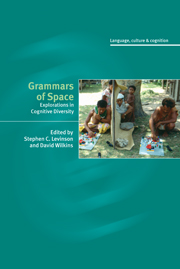Book contents
- Frontmatter
- Contents
- List of figures
- List of tables
- List of contributors
- Preface
- 1 The background to the study of the language of space
- 2 Towards an Arrernte grammar of space
- 3 Sketch of a Jaminjung grammar of space
- 4 Prolegomenon to a Warrwa grammar of space
- 5 The language of space in Yélî Dnye
- 6 Prolegomena to a Kilivila grammar of space
- 7 A sketch of the grammar of space in Tzeltal
- 8 Spatial reference in Yukatek Maya: a survey
- 9 Approaching space in Tiriyó grammar
- 10 Elements of the grammar of space in Ewe
- 11 Spatial language in Tamil
- 12 A grammar of space in Japanese
- 13 Some properties of spatial description in Dutch
- 14 Patterns in the data: towards a semantic typology of spatial description
- Appendices
- References
- Author index
- Language/Language family index
- Subject index
11 - Spatial language in Tamil
Published online by Cambridge University Press: 22 September 2009
- Frontmatter
- Contents
- List of figures
- List of tables
- List of contributors
- Preface
- 1 The background to the study of the language of space
- 2 Towards an Arrernte grammar of space
- 3 Sketch of a Jaminjung grammar of space
- 4 Prolegomenon to a Warrwa grammar of space
- 5 The language of space in Yélî Dnye
- 6 Prolegomena to a Kilivila grammar of space
- 7 A sketch of the grammar of space in Tzeltal
- 8 Spatial reference in Yukatek Maya: a survey
- 9 Approaching space in Tiriyó grammar
- 10 Elements of the grammar of space in Ewe
- 11 Spatial language in Tamil
- 12 A grammar of space in Japanese
- 13 Some properties of spatial description in Dutch
- 14 Patterns in the data: towards a semantic typology of spatial description
- Appendices
- References
- Author index
- Language/Language family index
- Subject index
Summary
Tamil and Tamils
The Dravidian language family is one of the world's major language families with perhaps 200 million speakers speaking approximately twenty-five mutually unintelligible languages. There are four major literary Dravidian languages all of which are indigenous to South India. Three of these major Dravidian languages are in the South Dravidian branch: Tamil, Kannada and Malayalam.
Following the 1991 Indian Census data (http://www.censusindia.net/), native Tamil speakers make up about 6.3 per cent of the total Indian population. The majority of these speakers (48,434,744) live in the state of Tamil Nadu where they constitute 86.7 per cent of that state's population. They make up the largest minority language population in Kerala, with 616,010 native speakers (2.1 per cent) and there are perhaps another 2 million native speakers elsewhere in India. Including the Indian population, there are perhaps 70 million speakers worldwide with substantial minority populations in Malaysia, Singapore, Sri Lanka and elsewhere.
Tamil has a continuous written history with records dating back approximately 2,000 years. There has also been a long tradition of mutual influence with Sanskrit and other ancient Indian languages and literatures. The classical Tamil period dates to perhaps as early as 300 BCE, a period in which the Tolkaappiyam was produced, a grammar apparently modelled on Pannini's Sanskrit grammar. Because of the age and probable linguistic conservatism of these writings, classical Tamil forms often resemble what is reconstructed for Proto-Dravidian spoken over 3,000 years ago.
- Type
- Chapter
- Information
- Grammars of SpaceExplorations in Cognitive Diversity, pp. 400 - 436Publisher: Cambridge University PressPrint publication year: 2006
- 16
- Cited by

